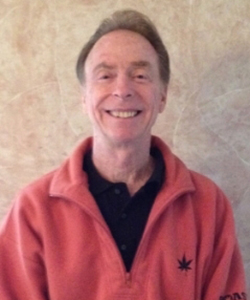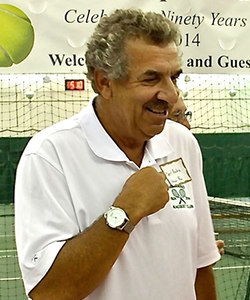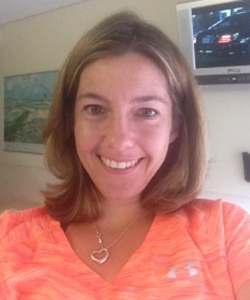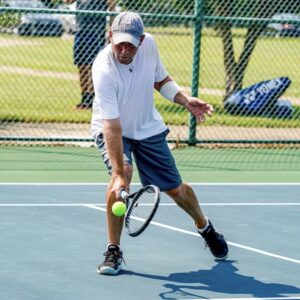Our Staff

Barry Grube
General Manager and Tennis Director
Email Barry
410-821-1644 Club
443-980-0860 Cell
Barry has more than 25 years of teaching and management experience. Initially, he trained under Dennis Vandermeer and Lew Gerrard. He has been the general manager and tennis director at Chartwell Country Club, Friends Racquet Club , Meadowbrook Tennis Club and The Cross Keys Indoor Tennis Club all in the local Baltimore area. Throughout his playing career, he held high state, sectional and national rankings.

Carl Rubin
Head Pro
Email Carl
410-821-1644 Club
410-236-0134 Cell
Carl has been teaching in the local area for more than 25 years and has directed the tennis programs at The Baltimore and the Hillendale Country Clubs. Besides his teaching experience, he brings the knowledge and organization of Men’s and Ladies’ Interclub, round robins, mixers and junior activities.

Kristin Missmer
Assistant Pro
Kristin was an ITF Pro circuit tour player. She was ranked #1 women’s player in Maryland and was a record holder member of the Ohio State University tennis team. Currently, Kristin is a tennis pro at the Coppermine Tennis and Fitness Club and conducts junior and adult clinics as well as private lessons.

Jamie Peterson
Email Jamie
410-821-1644 Club
443-668-6040 Cell
Jamie is currently the Women’s head tennis coach at Towson University. He was the tennis director at the Chartwell and Hillendale country clubs.. Jamie has and still holds State, sectional and national rankings. He is available for group and individual lessons.
Bob Dawson
Office / Maintenance
Bob is the guy who gets our courts in prime condition weekday mornings. He is also versed in our Chelsea Online Reservation System. Beyond the above, he helps maintain the common area and other general court maintenance responsibilities. He is a big part of keeping our facility running smoothly.
Our History
It all began with Carl Wheelock. In the winter of 1923-24, Carl told his wife, Margaret, that the potential for tennis existed in the neighborhood and that he intended to work on it. In July 1924, a group of 13 men headed by Wheelock met and formed a club they called the Pinehurst Racquet Club. The first order of business was a big one – there were no courts. That, as it turned out, was just a formality. They found a lot in Pinehurst, just east of Bellona Avenue at Pinehurst Road and talked the developer into letting them use it for tennis courts. Within a month of their meeting, they built 2 courts by hand. First came grading and then clearing the surface of roots, rock and what have you until it was ready for a top-coat of two truck-loads of very fine white clay. Posts and chicken wire screens were added and the club was in business.
The first singles championship was held that fall and by then membership had almost doubled. The club continued to grow to around 50 members and in 1925 another court was added. But at the end of the 1926 season, the courts were literally pulled out from under the club. The developer had found a buyer for his lot and the club was back where it started.
But not for long. Carl Wheelock had noticed 6 rundown, poorly maintained courts on the south side of Friends School located off Charles Street in Baltimore a few blocks south of the Baltimore County line. He saw an opportunity for a partnership. The Pinehurst Club would offer to fix up and maintain the courts in return for playing privileges on weekends and during the summer. The offer was made, and after some tough negotiating with Friends, a deal struck. Minutes of a club meeting on June 20, 1927 noted that six courts were ready for play. They also chronicled a change in the club’s name to make it more reflective of its growing regional membership: the Homeland Racquet Club.
Fast forward to 1961. The Homeland Racquet Club now had an Inc. after its name, additional courts and a membership of about 130 players. It also had a festering problem. The clay courts had become outmoded, and an agreement with Friends that had the school maintaining the courts was proving unsatisfactory. A new agreement was reached. Homeland would install new HarTru courts and maintain them. The cost of membership would go up, but so would the quality of playing conditions. This was no small undertaking, but then, as now, Homeland members pitched in and offered their services. Two names came up in the history of this big leap to better quality; Ray Tompkins who would later oversee the operation as president and Fenner Goldsborough who initiated the project. Here’s how I came to know them.
In 1966, recently arrived from Chicago, I was looking for a place to play. Someone mentioned Homeland, and one spring day after work, I stopped by Friends to see what it looked like. When I arrived, a good singles match was going on in the middle front court between the aforementioned Ray and Fenner. As I watched from the back fence, a ball rolled near me. Ray came to pick it up, and I commented on their good play. “You play?”, he asked. I said “I do” and his next question was, “Are you any good?” How do you answer a question like that?! Turns out I gave the perfect answer. I said I was better than either of them. In a few weeks, after a trial match, Homeland was my club.
Then, as of now, it attracted some of the best players in Baltimore; men and women. Better players applying for membership were given priority on the waiting list. They in turn attracted players who wanted to be associated with a player’s club. Homeland was and still is a no-frills club. When I joined, there was not even a storage shed, and bathroom facilities were only available in the school gymnasium above the courts. They were rarely used.
Fast forward to 1983. Homeland had enjoyed a good run at Friends and was firmly ensconced on many fronts as a contributing member of the Maryland tennis community. Its members served as officers and committee people of the USTA/Maryland Tennis Association with several becoming its president. It ran USTA sanctioned tournaments which included first-ever Maryland tournaments in the 35, 40 and 50 age divisions. Homeland players were consistently prominent in year-end Maryland and Mid-Atlantic rankings – to name a few would slight the many. But no one would question the fact that when I joined the club in 1966, Ray Bender, Jimmy Maldeis, Morty Greenberg, Ken Volk, Charlie Brooke, Mickey Pardew and son, Mac, were real standouts. Homeland teams were a force to be reckoned with, more often than not ending up on top of league standings at season’s end. True to its calling, it was a player’s club, but not elitist. The #1 qualification an applicant needed to be a member of the club then as now was a love of tennis.
Despite its success and well-being, a specter of the past hung over the club like the Sword of Damocles. Rumors would not go away that the land would be repurposed for school expansion. (In 2005, the Baltimore Sun featured an article about a new building at Friends School on the site where the courts had been. The sword had finally fallen.) As early as 1979, the possibility of a new club site on Melrose Avenue had been explored and, but for zoning, Homeland might be located there today.
In 1983, Eddie Jacobs, one of the best players to ever come out of Baltimore, approached the club and urged it to move to St Paul’s School located off Falls Road north of the beltway. He had started a tennis club at St Paul’s, but with only 45 members it was not self-sustaining. Eddie was dying of cancer and wanted to see his club in good hands before he died.
Contact was made with St Paul’s in the summer of 1983 by Bill Slautterback, President of Homeland. He learned that despite investing over $150,000 in 4 hard and 8 HarTru courts, St Paul’s was unable to attract a profitable number of members. Bill pointed out that it takes good players to attract tennis players. Homeland had good players, and St Paul’s had a lot to offer Homeland. Bill did a study that showed a move to St Paul’s would benefit Homeland financially and give it greater security with opportunity for both growth and expansion.
In 1984, Homeland and its 190 members (15 of whom were former members of the St Paul Club) moved to St Paul’s. The club was quick to take advantage of the opportunities not possible at Friends. By May, 1985, headed by the efforts of Ed Hale, it had its first-ever clubhouse that had locker room facilities and a room where the club pro could carry out operations. Two HarTru courts were added the following year for a total of 10 HarTru and 4 hard courts. There was more parking, and being less than a mile from the beltway off Falls Road, it had better accessibility to the tennis community at large tat contributed to expanded membership. There was also the bucolic setting of St Paul’s. The Homeland Club had found its home. When Homeland was firmly ensconced at St Paul’s, Eddie Jacobs, no longer able to play, would come to the courts and sit in a lounge chair on the hill behind the first court to be near the game he loved to the very end.
Despite more courts and a clubhouse, something was missing to make the picture complete. Court maintenance continued to be a problem, and it was not for want of trying. From day one, Homeland members were intimately involved in court maintenance. When the HarTru courts were installed in 1961 and the club took over maintenance from Friends, things did not get much better. And with the HarTru came an annual job that left members stiff and sore for a week or more. Each spring a flat-bed truck loaded with 80-pound bags of HarTru would pull up to the club, and it was all hands on deck hauling and spreading the HarTru and nailing down tapes. My back gets sore just thinking about it. And face it, none of us were in the business. Could that have had something to do with it? There was a collective sigh of relief when the job was hired out. More dues? Gladly!
In 1987, Larry came on the scene, and overnight court maintenance became a thing of pride and joy. And thanks to Barry Grube, it still is.I was on the committee in 2006 to select the club’s next pro/manager. There were candidates with strong credentials, but when Barry Grube’s name came up, our search was declared over. Our faith in him has proved well-placed. With Carl Rubin and Kris Messmer on board, Homeland has an unrivaled staff.
Harry Kimball was a club fixture – never too busy to attend to whatever might need doing for the club. When Harry died, an award was established in his name to recognize Homeland members for extraordinary service. Past recipients are Urb Moss, Cathy Kane, Bill Collins, Larry Melfa, Curtis Anderson, and Caddi Schanck. The award is given only when the board decides that a member in the mold of Harry Kimball should be recognized. In 2014, Gil Reynolds was so honored. Gil was club treasurer for over 20 years and an active member of the board, especially where court and building maintenance was concerned. Harry would be proud having Gil on his list.
The Homeland Racquet Club, now 375 members strong, celebrated its 90th anniversary on September 13, 2014, and at the same time its 30-year partnership with St Paul’s, a relationship considered by the Homeland Club to be its greatest asset.


